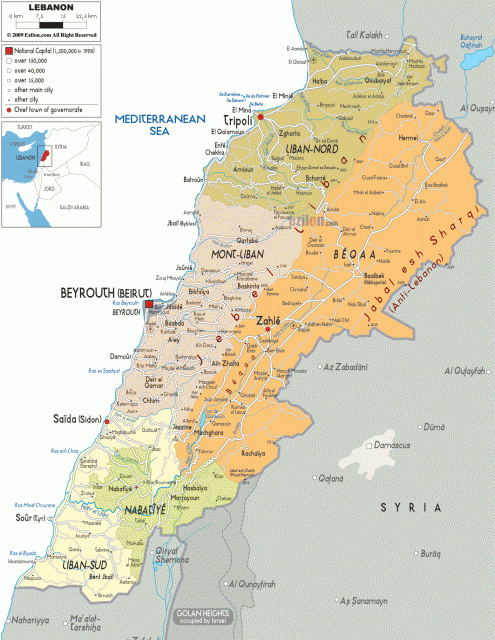Lebanon
Area 4,015 square mi (10,400 square km)
Population 4.547 million 2014
Capital Beirut
Highest Point 10,131 ft (3,088 m)
Lowest Point 0 m
GDP $45.73 billion 2014
Primary Natural Resources limestone, iron ore, salt, water, arable land.
LEBANON, ONE OF the world's smallest countries, is on the eastern shore of the MEDITERRANEAN SEA. SYRIA is its neighbor to the north and east, and ISRAEL is located to the south.
Although a small country, Lebanon has a wide range of geographical regions. All of the major cities are located on the coastal strip. The Mount Lebanon Range located inland, provides majestic peaks and ridges. The Bekaa Valley, located parallel to the coast, is home to a multitude of wine vineyards.

Thousands of years ago, the mountains of Lebanon were covered with great cedar forests. Only a few cedar forests remain, but Lebanon is still recognized as the most densely wooded country in the Middle East. Many pine trees cover the mountain land, and fruit trees are present all across the coastal plain. The mountains are home to many different birds, including eagles, red kites, Sardinian warblers, and Scop's owls. The climate in Lebanon is as diverse as the topography. Along the coast, hot conditions are prevalent during the summer, and cool, moist weather during the winter months. Snow and wind are common in the Bekaa Valley during the winter, and the mountains provide a typical alpine climate year-round.
The French created Lebanon in 1920. Originally, the Maronites, the largest religious community in the country, were placed in control of the government. However, to ensure the Maronites would remain loyal to the French, the French enlarged Lebanon to include mainly Muslim areas in the state. After this inclusion, only 30 percent of the population was Maronite. The tight grip of the French would last for decades, and the religious differences would last for the rest of the century. In 1926, the constitution was passed; a single chamber of deputies was created that could elect a president. The president had limited authority to choose a prime minister and the cabinet. However, the French rule continued to control Lebanese foreign relations and the military. By 1936, French and Lebanese government officials signed a treaty that included a guarantee of fairness to all religious sects in the country. The Maronite Christian Emile Edde was elected president and he chose a Muslim, Khayr al-Din al-Ahdab as the prime minister. This power sharing formula continued until the late 1980s.
The French left Lebanon after World War II, and for the next two decades, the Lebanese people tried to create a separate identity. In the early 1970s, many Palestinian Liberation Organization (PLO) fighters infiltrated the country. They conducted raids against the Israelis from southern Lebanon and urged many Palestinian refugees in Lebanon to fight for their cause. By April 1975, tensions reached new levels as civil war broke out in Lebanon. The conflict sided the Christian Maronites against the Muslim Lebanese National Movement (LNM). The Palestine Liberation Organization (PLO) soon joined the Muslim forces. One year later, the Syrian army intervened and, with Arab League support, worked out a cease-fire. By October 1976, an Arab Deterrent Force, mainly of 40,000 Syrian soldiers, occupied Lebanon. However, tensions were still high.
On June 6, 1982, after years of PLO attacks, Israel invaded Lebanon with the goal of eliminating the PLO and creating a 25-mile security zone in southern Lebanon. The Israelis bombarded Beirut, hoping the
Christian militias would seize control of the government. By August 1982, the PLO evacuated Beirut and took refuge in eight different countries. The Christian Bashir Gemayel was elected Lebanese president but was assassinated a few weeks later. The Israelis immediately returned to Beirut. A multinational peace force returned to the country and Amin Gemayel became president. In June 1985, Israeli forces withdrew from Lebanon, but maintained a presence in the southern Lebanon security zone. The country remained divided for the next six years. On May 22, 1991, the Lebanese government signed a Treaty of Cooperation and Brotherhood. Syria was given control over Lebanon's internal affairs and had around 16,000 troops stationed in the country. In 2005, under international pressure, Syria began to withdraw those troops.
Lebanon has attempted to pick up the pieces from the years of war. Muslims have been given a greater role in the government. Although the militant group, Hezballah still retains its weapons, most of the militias have been weakened or eliminated. The Lebanese armed forces have central government control over the majority of the country and Israel had withdrawn its forces from the southern security zone.